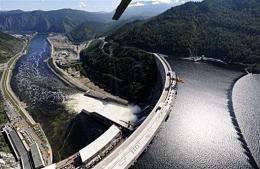New research questions hydroelectric emissions

Scientists have found that some reservoirs formed by hydroelectric dams emit more greenhouse gases than expected, potentially upsetting the climate-friendly balance of hydroelectric power.
A scientific study of Lake Wohlen in central Switzerland found "unexpectedly high" emissions of methane, a powerful greenhouse gas, the Swiss Federal Institute of Acquatic Science and Technology (EAWAG) said on Monday.
The 150,000 tonnes of methane bubbling up from sediment in the retention lake on the river Aare over a year are the equivalent of emissions from 2,000 cows, or 25 million kilometres (15.5 million miles) travelled by cars, EAWAG added in a statement.
"So hydropower isn't quite as climate-neutral as people have assumed in the past," said one of the scientists involved, Tonya Del Sontro.
"In the summer, the water in Lake Wohlen sometimes looks like champagne with masses of gas bubbles rising to the surface," she added.
The peer-reviewed research by scientists at Swiss, German and Israeli institutes was published in the US journal Environmental Science and Technology.
Joint author Bernhard Wehrli, a professor of aquatic sciences at Zurich's Federal Institute of Technology (ETHZ), said the study mirrored initial findings in research on tropical reservoirs, notably at the Kariba dam in Zambia.
Preliminary studies there had found "very high" inflows of carbon-rich material, forming sediment in the reservoir that released greenhouse gases, Wehrli told AFP.
However, he underlined that the complex process was highly dependent on temperature, depth and the amount of carbon rich organic material -- such as vegetation -- that accumulated in the sediment on the reservoir floor.
"We have done a study of high Alpine reservoirs that are in a better state in terms of methane emissions," he added. High altitude mountain reservoirs are generally in colder, more rocky and sparsely vegetated surroundings.
In the shallow Lake Wohlen, on the populated 500-metre (1,640 foot) high plateau near the Swiss capital Berne, the reservoir captures large amounts of organic material that would flow along the rive Aare.
"It's not the fault of the reservoir builders that there are emissions, but because the flow of the river is slowed down," Wehrli explained.
That allows the organic material to ferment and produce gas that bubbles up to the surface.
(c) 2010 AFP















